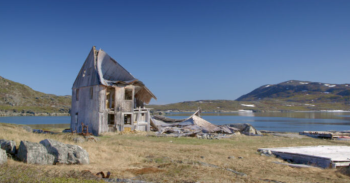Image Caption
Summary
Local Journalism Initiative Reporter
Windspeaker.com
Holly Andersen is obviously hoping her film Hebron Relocation will be seen extensively.
So the filmmaker, who lives in the town of Makkovik in Nunatiavut, an autonomous area claimed by the Inuit in Newfoundland and Labrador, is excited that Hebron Relocation will have its world premiere at the Canadian international documentary film festival Hot Docs. The festival begins April 27 and continues until May 7 in Toronto.
The film is about the 1959 forced relocation of Inuit people from their Labrador community of Hebron. In her film Andersen speaks to family members and friends of those who were relocated.
The doc focuses on how the relocation has had generational impacts on Labrador Inuit.
Andersen is thrilled her film will have its debut in Canada’s largest city.
“That’s a great big one to start with,” Andersen said of the Hot Docs festival.
More than 200 documentaries from around the world will be shown at the Toronto event.
Hebron Relocation, a 15-minute film, will have two screenings.
For starters, it will be shown on May 3 at the Scotiabank Theatre at 5:30 p.m. The second screening is scheduled for May 7 at the TIFF Bell Lightbox at 8:30 p.m. The film can also be streamed in Canada from May 5 to May 9. Go to https://hotdocs.ca/ for more information.
“It’s amazing,” Andersen said. “I knew we submitted it for the festival. But I really didn’t think it was going to be selected.”
In fact, Andersen was convinced her film would not be included in the Toronto festival, so she booked herself a recent trip to visit friends in Montreal and Oshawa, located about a half-hour drive from Toronto.
And then once word arrived that Hebron Relocation would indeed be part of Hot Docs, Andersen had to make plans for another trip west to attend the Toronto festival.
Hebron Relocation has also been submitted to other festivals in British Columbia, Alberta and in the United States. But Andersen has yet to receive word on whether it will be accepted into any of those other events.
Andersen’s current house was one of those that were hastily built to accommodate the more than 200 residents of Hebron that were forced to leave their community more than six decades ago and be divided up into other southern centres.
Andersen, who is 38, had some limited knowledge about the relocation from various members of her community. But she admits her knowledge of the move only began to take off when she started doing some research.
“Once I started to learn more, I thought I really want to do that now,” she said of the making of her film.
Various members of her current community, including family members of those who were forced to move, provide their thoughts of the relocation for the film.
Andersen is hoping that those who view her film realize that Inuit people were not looking for a drastic change in their lives.
“The message I want people to take away is mainly be kind to people,” she said. “In general, a lot of the people that were relocated didn’t have a say in the matter. It was the government, health officials and the church that decided this would happen.”
For many of those relocated, government promises of housing did not come right away. Houses were not built in time and many of those that were forced to move had to spend several months living in harsh conditions in tents.
Since they were unfamiliar with the hunting and fishing in their new communities, many of the Hebron community members starved upon relocation. Others committed suicide since they were unhappy with their new surroundings.
As a result, Andersen knew she had to sensitively work on aspects of the relocation in her film.
“Still to this day there is generational trauma going on,” she said. “I wanted to make sure that if those who were relocated were watching this, it wouldn’t trigger anything.”
Hebron Relocation was produced via the Labrador Documentary Project. This project, which features first-time Labrador Inuit filmmakers, aims to create and distribute Inuit stories from Inuit perspectives.
Andersen hopes her short documentary might be turned into a full-length feature film one day.
“Right now, I want to see and feel the buzz of this and see if anybody reaches out to do that,” she said.
Never miss a Windspeaker article. Subscribe Today to our new Windspeaker Newsletter!
Local Journalism Initiative Reporters are supported by a financial contribution made by the Government of Canada.

